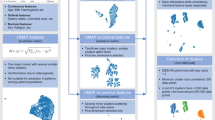Abstract
Syndrome differentiation is the character of Chinese medicine (CM). Disease differentiation is the principle of Western medicine (WM). Identifying basic syndromes feature and structure of disease of WM is an important avenue for prevention and treatment of integrated Chinese and Western medicine. The idea here is first to divide all patients suffering from a disease of WM into several groups in the light of the stage of the disease, and secondly to identify basic syndromes feature in a distinct stage, and finally to achieve the purpose of syndrome differentiation. Syndrome differentiation is simply taken as a classifier that classifies patients into distinct classes primarily based on overall observation of their symptoms. Previous clustering methods are unable to cope with the complexity of CM. We therefore show a new multi-dimensional clustering method in the form of general latent structure (GLS) model, which is a suitable statistical learning technique of latent class analysis. In this paper, we learn an optimal GLS model which reflects much better model quality compared with other latent class models from the osteoporosis patient of community women (OPCW) real data including 40-65 year-old women whose bone mineral density (BMD) is less than mean-2.0 standard deviation (M-2.0SD). Further, we illustrate a case analysis of statistical identification of CM syndromes feature and structure of OPCW from qualitative and quantitative contents through the GLS model. Our analysis has discovered natural clusters and structures that correspond well to CM basic syndrome and factors of osteoporosis patients (OP). The GLS model suggests the possibility of establishing objective and quantitative diagnosis standards for syndrome differentiation on OPCW. Hence, for the future it can provide a reference for the similar study from the perspective of a combination of disease differentiation and syndrome differentiation.
Similar content being viewed by others
References
Zhang NL, Yuan SH. Latent structure models and syndrome differentiation in traditional Chinese medicine (I): The basic idea and tools for latent structure analysis. J Beijing Univ Chin Med (Chin) 2006;29:365–369.
Zhang NL, Yuan SH. Latent structure models and syndrome differentiation in traditional Chinese medicine (II): Data analysis of Kidney Deficiency. J Beijing Univ Chin Med (Chin) 2008;31:584–587.
Zhang NL, Yuan SH. Latent structure models and syndrome differentiation in traditional Chinese medicine (III): syndrome differentiation through model and experts. J Beijing Univ Chin Med (Chin) 2008;31:659–663.
Cheng SD. Huangdi’s Internal Classic. 2nd Edition. Beijing: People’s Medicine Publishing House (Chin) 2006;410-417.
China Association of Chinese Medicine.Guidelines for Diagnosis and Treatment of Common Internal Diseases in Chinese Medicine: Diseases of Modem Medicine. Beijing: China Press of Tradit Chinese Medicine (Chin) 2008;242–245.
Xie YM, Zhu YY, Ge JR. Xing MR. Study on the CM general syndrome of osteoporosis based on the clinical epidemiological investigation. Wor Sci Tech-Mod Tradit Chin Med Mate Med (Chin) 2007;9:38–44.
Zhang NL. Hierarchical latent class models for cluster analysis. J Mach Learn Res 2004;5:697–723.
Zhang NL, Yuan SH, Chen T, Wang Y. Latent tree models and diagnosis in traditional Chinese medicine. Artif Intel Med 2008;42:229–245.
Liu SJ, Zhu Q. Study on Quantificational Diagnostic Standard of Deficient Syndrome of the Spleen Qi in CMs Maternity. China J Basic Med Tradit Chin Med (Chin) 1998;4:49–51.
Yang XP. Yin-Yang Qi and Variables. Beijing: Sci Press 1993.
Hua D, Chen D, Cheng X, Youssef A. Latent structure models for the analysis of gene expression data. In Proc IEEE Comp Soc Bioinf 2003;496–499.
Bartholomew DJ, Knott M. Latent variable models and factor analysis, 2nd ed. Kendall’s Lib Statis 7, London: Arnold; 1999.
Neapolitan RE. Learning Bayesian networks. New York: Prentice Hall; 2003.
Sullivan PF, Smith W, Buchwald D. Latent class analysis of symptoms associated with chronic fatigue syndrome and fibromyalgia. Psych Med 2002;32:881–888.
Wasmus A, Kindel P, Mattussek S. Activity and severity of rheumatoid arthritis in Hannover/FRG and in one regional referral center. Scandinavian J Rheumatol 1989;79:33–44.
Uebersax. A practical guide to local dependence in latent class models, 2000. ourworld.compuserve.com/homepages/jsuebersax/condep.htm.
Zhang NL, Kocka T. Efficient learning of hierarchical latent class models. In Proc ICTAI 2004; 20: 585–593
Friedman N. Learning belief networks in the presence of missing values and hidden variables. CML 1997;125–133.
Schwarz G. Estimating the dimension of a model. Ann Statis 1978;6:461–464.
Chickering DM. Learning Equivalence Classes of Bayesian-Network Structures. J Mach Learn Res 2002;2:445–498.
Huang HX, Chai ST. Cluster analysis of syndrome patterns of osteoporosis in traditional Chinese medicine. J Guangzhou Univ Tradit Chin Med (Chin) 2007;24:180–183.
Wang XX, Zhang YL, Huang QF. Discussion on the main pathogenesis in traditional Chinese medicine and etiology about primary osteoporosis. J Chin Integr Med (Chin) 2010;18:1119–1123.
Li YH, Xue L, Zhao FF. Distribution of Chinese syndrome types in patients with primary osteoporosis and its relationship with bone fracture. Chin J Integr Tradit West Med (Chin) 2010;30:493–495.
Author information
Authors and Affiliations
Corresponding author
Additional information
Supported by Items of Institute of Basic Research in Clinical Medicine, China Academy of Chinese Medical Sciences Natural Science Fundation (No. 30873339)
Rights and permissions
About this article
Cite this article
Yang, W., Yi, Dh., Xie, Ym. et al. Statistical identification of syndromes feature and structure of disease of western medicine based on general latent structure model. Chin. J. Integr. Med. 18, 850–861 (2012). https://doi.org/10.1007/s11655-012-1118-7
Received:
Published:
Issue Date:
DOI: https://doi.org/10.1007/s11655-012-1118-7




